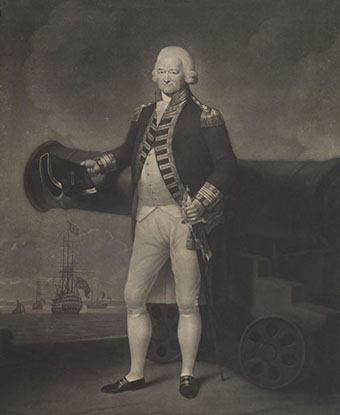Last updated: January 9, 2020
Person
Peter Parker

National Galleries of Scotland
Born in Ireland, Peter Parker was the third son of Rear Admiral Christopher Parker and Margaret Nugent. Part of a naval lineage, Parker was the father of Vice-Admiral Christopher Parker, the grandfather of Captain Sir Peter Parker, and the uncle of Admiral Sir George Parker. His grandson and namesake served under Sir George Cockburn in the Chesapeake during the War of 1812 and was mortally wounded on the night of August 30, 1814 when he led a party ashore in Maryland.
Promoted to commander in 1735, Parker's first significant service came in a squadron under Admiral Edward Vernon in 1739 during the War of Jenkins' Ear. Parker later saw action again during the War of the Austrian Succession, notably in the British defeat at the Battle of Toulon in which a Franco-Spanish fleet broke the British blockade. Promoted to captain in 1747, he next saw significant combat action in the Seven Years' War. Commanding the Bristol, he participated in the invasion of Guadeloupe in May 1759. In the spring of 1761, he participated in the amphibious assault and capture of Belle Île, a French island off the Brittany coast. He retired from active service in 1763 at the end of the war.
Knighted in 1772, Parker was given command of the Barfleur when he rejoined the service in 1773. In December 1775, Parker commanded a fleet, departing Portsmouth for Cork, Ireland to embark six regiments commanded by Lord Charles Cornwallis, destined for the shores of North Carolina to support loyalists. Learning of the defeat of loyalists at the Battle of Moores Creek Bridge, Parker directed the fleet south to attack Charleston, South Carolina. His relations with General Henry Clinton, commanding army forces, worsened as the expedition continued. Clinton's comments on the British naval attack on Sullivan's Island explain the difficulties the Royal Navy faced:
"The Materials with which Fort Sullivan is constructed form no inconsiderable part of its strength. The Palmetto Tree, of a spongy substance, is usd in framing the Parapet & the interstices fill'd with sand. We have found by experience that this construction will resist the heaviest Fire. -The Passage between Long Island & Sullivan's Island was represented as fordable at Low water, but this representation was founded in a mistake, there remain'd therefore no method of crossing but in Boats under the Fire of the enemys Cannon & breastworks...For any further particulars relative to this affair and for the motives which determin'd the Commodore (Parker) to make the attack in which he knew he could receive no assistance from the army, I must refer you to accounts from other hands - From this account it appears - that it would have been highly imprudent in the Land Forces to have attempted the passage; - That Sr P Parker knew at the time of his making the attack that they did not intend it, and yet had made no preparations to possess himself of the Fort, which otherwise he might have done during the time that the Fire was silencd, and the enemy had abandon'd it.”
Parker was wounded in the battle as patriot artillery fire raked the deck of the Bristol. His reputation emerged intact after the defeat as he and Clinton blamed each other for the defeat to their superiors in Britain. Afterwards, he led the fleet north and supported Lord Richard Howe's fleet in the New York campaign and commanded the squadron that convoyed Clinton to Newport, Rhode Island in December 1776.
As military commander in chief of Jamaica, 1777-81, under Governor Dalling, he protected the prize of Britain's overseas possessions from French attack. Parker ignored Clinton's requests for naval support to protect Mobile and Pensacola against Spanish attack. In 1779, Parker dispatched forces on the Omoa campaign, a mission to capture Spanish treasure ships at a fortress on the Honduran coast. In May 1782, having been succeeded by Rear Admiral Thomas Graves in 1781, Parker left for England aboard the Sandwich, Admiral George Rodney's flagship which carried the defeated French Admiral Comte de Grasse and his officers from the Battle of the Saintes.
Parker was created a baronet in 1782, served as member of Parliament for Seaford from 1784-6, and was promoted to admiral in 1787. In 1793, he was appointed commander in chief at Portsmouth, a prestigious position in the Royal Navy. He eventually succeeded Lord Howe as Admiral of the Fleet in 1799. Parker's final public service was the chief mourner at Vice Admiral Lord Horatio Nelson's funeral on January 9, 1806. He died at Weymouth Street, London, on December 21, 1811.
